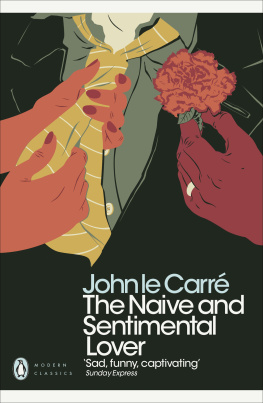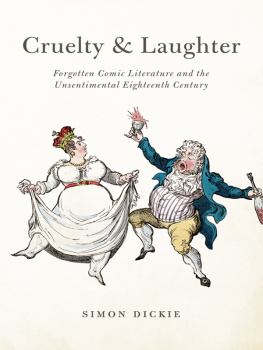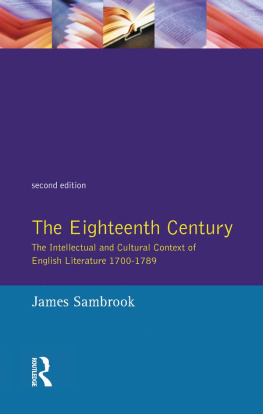An Archaeology of Sympathy
The Sentimental Mode in Literature and Cinema
JAMES CHANDLER
The University of Chicago Press
Chicago & London
James Chandler is the Barbara E. and Richard J. Franke Distinguished Service Professor in the Department of English Language and Literature and chair of the Department of Cinema and Media Studies at the University of Chicago. He is the author of several books, including England in 1819: The Politics of Literary Culture and the Case of Romantic Historicism, also published by the University of Chicago Press.
The University of Chicago Press, Chicago 60637
The University of Chicago Press, Ltd., London
2013 by The University of Chicago
All rights reserved. Published 2013.
Printed in the United States of America
22 21 20 19 18 17 16 15 14 13 1 2 3 4 5
ISBN-13: 978-0-226-03495-9 (cloth)
ISBN-13: 978-0-226-03500-0 (e-book)
DOI: 10.7208/chicago/9780226035000.001.0001
Library of Congress Cataloging-in-Publication Data
Chandler, James, 1948 author.
An archaeology of sympathy : the sentimental mode in literature and cinema / James Chandler.
pages cm
Includes bibliographical references and index.
ISBN 978-0-226-03495-9 (cloth : alkaline paper)
ISBN 978-0-226-03500-0 (e-book)
1. Sentimentalism. 2. Sentimentalism in motion pictures. 3. Capra, Frank, 18971991Criticism and interpretation. 4. Sentimentalism in literature. 5. English literatureHistory and criticism. I. Title.
PN56.S475C47 2013
809'.9145dc23
2012044801
 This paper meets the requirements of ANSI/NISO Z39.48-1992 (Permanence of Paper).
This paper meets the requirements of ANSI/NISO Z39.48-1992 (Permanence of Paper).
For CATHERINE and MICHAEL and JONAH and JACK
SENTIMENTALE SEELEN
Sie weinen! ach! der Metzger schlachtet ein Kalb!
Erst brllte die Bestie noch, jezt ist sie falb!
Sie lachen! Himmel, wie nrrisch in seiner Art,
Natur, Natur! Ein Hund trgt keinen Bart!
Was sprudelt ihr hoch, als wart ihr gesonnt?
Wir hren, wie Bielams Esel gar sprechen konnt!
KARL MARX
When I mounted my hobby horse, I never thought, or pretended to think, where I was going, or whether I should return home to dinner or supper, or the next day, or the next week. I let him take his own course; and amble, or curvet, or trot, or go a sober, sorrowful, lackadaysical pace, as it pleased him best. It was all one to me, for my temper was ever in unison with his manner of coursing itbe it what it might, I never pricked him with a spur, or struck him with a whip; but let the rein lay loosely on his neck, and he was wont to take his way without doing injury to any one.
Some would laugh at us as we passed along, and some seemed to pity us, and now and then a melancholy tender-hearted passenger would look at us and heave a sigh.Thus have we travelled together; but my poor Rosinante did not, like Balaams ass, stand still if he saw an Angel in the way, but directly pushed up to her, and if it were but a damsel, sitting by the fountain, who would let me take a refreshing draught from her cup, she was, surely, an angel to me.
The grand error of life is, that we look too far:we scale the Heavens, we dig down to the centre of the earth, for systems, and we forget ourselves.Truth lies before us; it is in the highway path; and the ploughman treads on it with his clouted shoon.
Nature defies the rule and the line;Art raises its structures, and forms its works on their aid; but Nature has her own laws, which Art cannot always comprehend, and Criticism can never reach.
LAURENCE STERNE
Contents
Preface
This book is about a distinctively modern rhetorical mode or mood with wide influence across forms and genres, about how it took shape in the medium of print and how it was adapted to the medium of film. I use rhetorical in the broad sense here to include questions of narrative, address, and moral posture. By distinctively modern I mean roughly since the European Enlightenment, though important elements of my account derive from the mid-seventeenth century. The story I tell comes up to our own moment. Insofar as it claims to be an archaeology, it might even be said to begin there. Still, the rapid social and cultural development of Britain in the mid-eighteenth century remains a special point of focus of the book because it was there and then that the term sentimental was first coined, there and then that what it identified really emerged. Scholars of this subject have long been aware that the first entry in the Oxford English Dictionary for sentimental involves a 1749 query about its already fashionable currency. One Lady Bradshaigh wrote to Samuel Richardson, the most influential writer of that decade, to ask, What, in your opinion, is the meaning of the word sentimental, so much in vogue among the polite? But even with the help of large, digitally searchable databases, antecedent instances of the term have been difficult to identify, even for the 1740s. Sentimental named something new under the sun in that moment, something Richardson himself had a lot to do with.
Mode and mood are interchangeable terms in some contextsin English grammar, for examplethough we more typically use the former to refer to a manner or fashion of proceeding (a modality) and the latter to indicate an affective condition, as in the title of a jazz composition by Duke Ellington, In a Sentimental Mood, which makes an appearance in one of the 1990s neo-Capra films that I survey in . Both terms, mode and mood, are relevant to my arguments. In categorizing this thing called the sentimental over the course of writing An Archaeology of Sympathy, I have in fact found myself toggling between the two terms. So for the purposes of a preliminary exposition I propose a single term, one that connotes both mood and mode. That term is disposition.
A disposition, nowadays, is first of all an emotional tendency or outlook. This is the sense invoked by Cornel West, in an interview at the Occupy Wall Street encampment on September 29, 2011, when he told Amy Goodman of Democracy Now! that President Obama should apologize to the Congressional Black Caucus for accusing its members, in effect, of whining: I tell my brother, you got to understand the genius of Bob Marley. He called his group the Wailers, not the Whiners. The Wailers were persons who cry for help against the context of catastrophe.... Whining is a cry of self-pity, of a sentimental disposition. Wests phrase not only captures the prevailing contemporary understanding of disposition as a psychological tendency; it also casts sentimental as unequivocally pejorative, a now-standard use of the term. The reduction of disposition to attitude and sentimental to self-pitying is precisely what this book seeks to roll back, in favor of a richer and more complex history of representational practices.
This brings me to a longer-standing set of associations with the term disposition, one with strong roots in classical learning. In Roman rhetoric, dispositio is the term for how some particular matter is disposedhow its component parts are ordered, organized, and arranged. The sentimental revolution in literature that dates from the mid-eighteenth century is not just about new kinds and levels of feeling but also about new ways of ordering works and organizing the worlds represented in them. It is this aspect of that revolution that interests me most. A startling challenge to traditional forms of disposition appears in the very first line of Laurence Sternes Sentimental Journey through France and Italy (1768), introduced with an extended dash: They order, said I, this matter better in France.tence itself: nothing is clearly set forth in this sentence. Rather than explain himself, Parson Yorick makes his remark the occasion for plunging headlong into a journey to the Continent, where he claims to have incontestably arrived by the middle of page one. This would indeed be a novel novel. For all the apparent idiosyncrasy and contingency of Sternes procedures, he was decidedly a pioneer of a new disposition, of new structuring principles in narrative art, and would eventually be recognized for this achievement in the twentieth century by Viktor Shklovsky, leading light of the Russian Formalist school of criticism.
Next page









 This paper meets the requirements of ANSI/NISO Z39.48-1992 (Permanence of Paper).
This paper meets the requirements of ANSI/NISO Z39.48-1992 (Permanence of Paper).